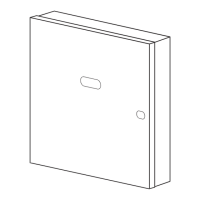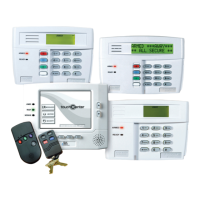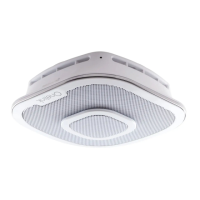– 60 –
Section 12. FINAL POWER UP
In previous sections, you made temporary power connections for the purpose
of programming and testing. This section provides information about final
power-up procedures and battery size calculations.
Earth Ground Connections
The designated earth ground terminal (21) must be terminated in a good earth
ground for the lightning transient protective devices in this product to be
effective. See the
INSTALLING THE CONTROL
section earlier in this manual.
AC Power-Up
1. Plug the AC transformer into a 24-hour, uninterrupted 120VAC outlet.
2. Following power-up, AC, dI (disabled), or Busy–Standby (Alpha keypads)
or NOT READY (fixed-word keypads) will be displayed. Also the green
"READY" LED on the keypad(s) should light.
After approximately 1 minute, the initial displays will revert to
DISARMED...READY TO ARM for Alpha keypads, or READY for Fixed-
word keypads (if there are no faulted zones). This 1-minute delay allows
PIRs, etc. to stabilize.
To bypass this delay, press: [#] + [0].
Note: If you do not get the “Ready” displays described above, make sure
that there are no faulted zones (doors, windows open, PIRs activat-
ed, etc). If necessary, refer to “Trouble Conditions” in the
SYSTEM
OPERATION
section, and also to the
TROUBLE-SHOOTING
GUIDE
section.
Connecting The Back-Up Battery
In the event of an AC power loss, the Control panel is supported by a back-up,
rechargeable gel cell battery. The minimum battery size recommended is the
No. 467 (12V, 4AH) battery. See “Calculating the Battery Size Needed” below.
The battery is installed in the control cabinet.
The standby battery connection is automatically checked every 3 minutes
(CSFM requirement). In addition, entry into the test mode will cause a battery
test to be initiated. If there is no battery or a low battery, a low battery message
is displayed and, if so programmed, will be reported to the central station.
Calculating
the Battery Size
Needed
Determine the total device current draw after filling in the AUXILIARY DEVICE
CURRENT DRAW WORKSHEET on the next page. To this figure add the
100mA that is drawn by the control panel itself. Then, to determine the battery
size needed, use the following formula:
Total Current Drawn* x Number of hours standby wanted = Battery Ampere/Hours.
* Convert mA figure to decimal Amps (see example).
Example:
If total auxiliary device current drawn is 450mA, add 100mA for the control
panel, for a total of 550mA (0.55 amps); if 24-hour standby is wanted, the
calculation will be:
0.55mA x 24 hours = 13.2 Ampere/Hour battery needed.
In this example, two 7 Amp/Hr batteries (connected in parallel) must be used.
Making the Battery
Connections
1. Use the battery standby formula (shown above) to select the appropriate
battery for the installation.
Remember, when calculating the battery size needed, you must add
the 100mA drawn by the control itself to the total Auxiliary current
draw in the worksheet on the next page.
Do not connect to the battery until all devices have been wired to the control.

